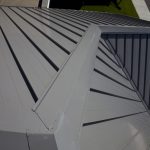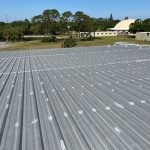
Decisions regarding walk doors going into a metal building can be complex or very simple. If the project has a hard spec for doors, the decisions on components are already made but the doors or corresponding hardware requirements can be difficult to source or may be very expensive compared to the available alternative options.
However, in many situations, there is no hard spec and the metal building manufacturer, contractor, or owner may want a basic or standard door that economically meets the unique needs of their building. With a myriad of door options available, it may sound more complex than it really is.
Certainly, there are many options available, so what key variables are most needed for the building application and/or owner expectations? Asking this question will better provide answers to drive the door selection—then it becomes much easier.
Metal buildings have evolved into many applications that go beyond true “commercial” jobs. Although we can use the Steel Door Institute (SDI) general guidelines for gauges and types, the variables for the actual building design use will really drive the required door. The emphasis on energy requirements and continued advancement to high-performance doors will continue to be critically important. So, what are those key variables when helping to steer the customer in the right direction?
Testing and performance
What levels of performance are needed (or desired), and are any testing registrations required? Florida and other coastal areas come to mind, as the Florida Building Code is utilized to ensure doors are tested to the minimal levels for wind speeds equating to structural strength. Doors operate in a wide variety of ways and even with common components, based on other factors they may show varying levels of performance achievements. The testing focuses on meeting structural and air/water infiltration performance levels, with missile testing as an additional test for those wanting to meet the coastline requirements. The unique consideration is that two similarly constructed doors may have different structural results, just because the manufacturer may choose to test to different levels. In essence, doors are not tested to failure, they are tested to the level a company wants to achieve. Ensure the doors are third-party tested and meet minimum foundational levels that make sense for the end-use application.
Insulating properties
Energy efficiency or thermal performance are talked about all the time, and they have become very meaningful in the construction world. What does it mean for doors and door openings? The current method for testing performance measurement is the National Fenestration Rating Council (NFRC) 100 or ASTM C1363 test that provides a U-value for the total opening, which includes the door, frame, threshold, and weather seal, and examines how they integrate together. The overlap with the air/water infiltration tests to the assembly U-value will provide a good reference point for the door’s performance. A door may be structurally sound but with gaps along the door/frame edge or poor assembly quality, U-values can be greatly impacted, and energy efficiency will suffer.
Having a thermal break in the door as well as the frame and threshold—defined as a full thermal break system—is the best bet for getting the desired U-values. ResCheck and ComCheck—software used to confirm code compliance—utilize a default value U-value of .60. Doors with the very common styrene core generally may have some improvement up to .40. However, some manufacturers have options for a polyurethane core along with the thermal barrier and can achieve U-values down to .20 to .25, which is significant for the overall building envelope calculations. Those types of doors can be very valuable to helping the building achieve the highest energy efficiency and reducing costs in other areas.
Door material
The actual material used in the door and frame is often overlooked. Steel doors and steel frames are the most common materials for many commercial/industrial door applications. However, often the end use of the door may call for or require something a bit different. Aluminum storefront doors provide a quality entrance for many office and retail buildings. Aluminum is a highly corrosive-resistant material that allows doors to remain attractive without the wear and tear that steel doors may show over time.
Buildings used for various agricultural purposes have often required the use of aluminum or fiberglass for animal confinement or other highly corrosive environments. Those materials are becoming more integrated into commercial building structures just for that reason, as the benefits of the corrosion-resistant material outweigh the benefits of steel.
Hardware

Hardware for doors can also be complex with so many options available. Defining the key variables in hardware is the best way to make a wise lock decision. Everyone is aware of mechanical and electronic locks that are very common in commercial and residential applications, so look at one key element of performance, which is the “grade” of locking hardware to use. This “grade” of the lock is determined by the level of performance testing standards the lock meets. In general, there are three levels of grades:
- Grade 1 – Heavy-duty commercial
- Grade 2 – Standard or light-duty commercial
- Grade 3 – Residential duty
The key for the grade of lock needed is mostly based on usage—how frequently it is used and how much abuse the lock will take daily. The most common performance standard to define different grades is the cycle test, whereby the lock is tested on a door, as the handle is depressed and the latch retracted a defined number of times—basically opening and closing a door in the manner it gets used. The heavy-duty Grade 1 requirement has a minimum 1 million cycle test. The Grade 2 lock standard is 400,000 cycles, and the residential lock Grade 3 standard is 200,000 cycles.
It is clear when comparing the varying locks that the Grade 1 is much heavier duty, meaning to meet the much higher cycle test—along with other tests—it requires much stronger and durable components. Although 200,000 cycles sound high, it does pale in comparison to 1 million or even 400,000. For most metal buildings, a Grade 2 lock should be the minimum standard to use, with the Grade 1 lock needed occasionally for high-use applications.
Finally, there are a high number of residential Grade 3 electronic locks with some very nice features, which many are tempted to use due to the low cost. The recommendation would still be to work with a door/hardware provider to find a comparable commercial Grade 1 or Grade 2 lock with similar features. Costs will be higher but long-term satisfaction will be better.
Summary
A key premise to the discussion on doors is not to find one door and then just use it for any building application. Although that would make the door decision easy, it does not do the building or the owner justice. Once the key variables have been determined a path can easily be charted to the correct door needed for different types of buildings.
Testing and performance level minimums are a good starting point to ensure basic structural requirements are met. The energy efficiencies gained through highly engineered products—especially those with a thermal break door and frame, which provide strong U-values are becoming more and more necessary.
Lastly, the use of materials can and should vary between diverse applications. Corrosive-resistant materials are gaining more traction in many commercial, industrial, and agricultural building applications.
Tom Granitz is V.P. of sales and marketing for Plyco Corp., Elkhart Lake, Wis. To learn more, visit plyco.com
or email tgranitz@plyco.com.





